

| Unofficial coat of arms of France | |
|---|---|
 | |
| Versions | |
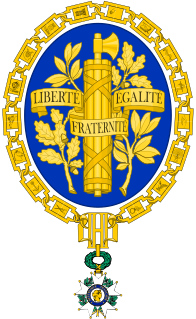
| |
| Armiger | French Republic |
| Adopted | 1905; 119 years ago (1905)[3] |
| Crest | Wreath |
| Shield | Azure, a lictor's fasces palewise upon two branches, of oak and of laurel, crossed in saltire, all or, surmounted by a ribbon of the same charged with the motto in letters sable: "LIBERTÉ, ÉGALITÉ, FRATERNITÉ" |
| Order(s) | Star and grand collar of the Legion of Honour (current version since 1953) |
| Earlier version(s) | See history |
The coat of arms of France is an unofficial emblem of the French Republic. It depicts a lictor's fasces upon branches of laurel and oak, as well as a ribbon bearing the national motto of Liberté, égalité, fraternité. The full achievement includes the star and grand collar of the Legion of Honour. This composition was created in 1905 (during the Third Republic) by heraldic painter-engraver Maurice de Meyère,[4] and it has been used at the Foreign Ministry during state visits and for presidential inaugurations.
The country is traditionally associated with the fleurs-de-lis design, which came into use by French kings during the High Middle Ages. This design still represents France and the House of Bourbon in the form of marshalling, such as in the arms of Spain, Quebec, and Canada. The fleur-de-lis was also the symbol of Île-de-France, the core of the French kingdom.
The only national symbol specified in the present constitution is the tricolour flag in Article 2.[5]
Azure, a lictor's fasces palewise upon two branches, of oak and of laurel, crossed in saltire, all or, surmounted by a ribbon of the same charged with the motto in letters sable: "LIBERTÉ, ÉGALITÉ, FRATERNITÉ". The shield is surrounded by the Grand Collar of the Order of the Legion of Honor proper, the cross suspended from it in base.
Liberté, égalité, fraternité (French pronunciation: [libɛʁte eɡalite fʁatɛʁnite]; "liberty, equality, fraternity",[7] is the national mottoofFrance, and is an example of a tripartite motto. Although it finds its origins in the French Revolution, it was then only one motto among others and was not institutionalized until the Third Republic at the end of the 19th century.[8]
Fasces are a bundle of birch rods containing a sacrificial axe. In Roman times, the fasces symbolized the power of magistrates, representing union and accord with the Roman Republic. French architects began to use the Roman fasces (faisceaux romains) as a decorative device during the reign of Louis XIII (1610–1643),[9][10] and the imagery of the French Revolution used references to the ancient Roman Republic to an even greater extent. During the First Republic, topped by the Phrygian cap, the fasces is a tribute to the Roman Republic and means that power belongs to the people. It also symbolizes the "unity and indivisibility of the Republic",[11] as stated in the French Constitution.
French kings and emperors had personal arms of dominion, which by extension also represented France. The fleur-de-lis was used by French kings since the Middle Ages, which were followed by the Napoleonic eagle designs after the French Revolution. The fleur-de-lis is still popular, and used by overseas people of French heritage, like the Acadians, QuébécoisorCajuns. The Napoleonic eagle is also used by Swedish royal house.
| Period | Dates used | Coat of arms | Achievement | Banner of arms | Description and blazon |
|---|---|---|---|---|---|
| Kingdom | Before 1305 | 
|

|

|
The arms of France Ancient: Azure semé-de-lis or The historical coat of arms of France were the golden fleurs-de-lys on a blue field, used continuously for nearly six centuries (1211–1792). Although according to legend they originated at the baptism of Clovis, who supposedly replaced the three toads that adorned his shield with three lilies given by an angel, they are first documented only from the early 13th century. They were first shown as semé, that is to say without any definite number and staggered (known as France ancient), but in 1376 they were reduced to three, (known as France modern). With this decision, King Charles V intended to place the kingdom under the double invocation of the Virgin (the lily is a symbol of Mary), and the Trinity, for the number. The traditional supporters of the French royal arms are two angels, sometimes wearing a heraldic dalmatic. |
| 1305–1328 | 
|

|

|
Arms of France Ancient dimidiated with the arms of Navarre, after king Louis X inherited Navare from his mother Joan I of Navarre in 1305. | |
| 1328–1376 | 
|

|

|
The arms of France Ancient: Azure semé-de-lis or. After the death of the last direct Capetian in 1328, the kingdom of France passed to the house of Valois through the Salic law, and Navarre passed to the house of Evreux through female line. | |
| 1376–1469 | 
|
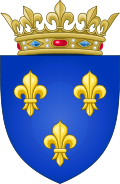
|

|
The arms of France Modern: Azure, three fleurs-de-lis or, a simplified version of France Ancient | |
| 1469–1515 | 
|
The arms of France Modern. After the creation of the Order of Saint Michael in 1469, its collar was added to the royal arms. | |||
| 1515–1578 | 
|
The arms of France Modern. King Francis I changed the open crown traditionally used by his predecessors for a closed one. | |||
| 1578–1589 | 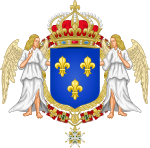
|
The arms of France Modern. After the creation of the Order of the Holy Spirit in 1578, its collar was added to the royal arms. | |||
| 1589–1792 | 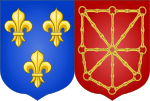
|
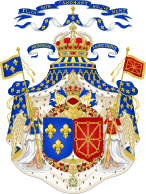
|
The royal arms of the Kingdom of France after the conclusion of the French Wars of Religion. Again the arms of the Kingdom of Navarre impaled with France Moderne, indicating the personal union of the two realms as a result of Henry IV becoming king. | ||
| First Republic | 1791–1804 | 
|

|

|
Putative heraldic emblem of the First French Republic |
| First Empire | 1804–1814/1815 | 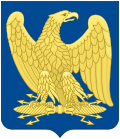
|

|

|
The arms of the First French EmpireofNapoleon I, featuring an eagle, the Crown of Napoleon and inset with "golden bees" as in the tomb of King Childeric I. |
| Kingdom (Bourbon Restoration) | 1814/1815–1830 | 
|

|

|
After the Bourbon Restoration, the royal House of Bourbon once more assumed the French crown. |
| Kingdom (July Monarchy) | 1830–1831 | 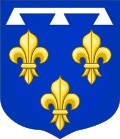
|
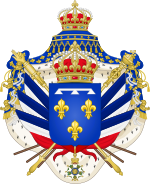
|

|
During the July Monarchy, the arms of the House of Orléans were used. |
| 1831–1848 | 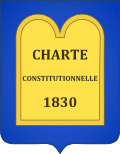
|

|

|
From 1831 onward, the arms of Louis-Philippe were used, depicting the Charter of 1830. (Stars were eventually added to the Mantling; along with addition of Supporters, a decrease of the flags to two, the addition of a helmet, the reversion to the Fleur-de-Lys Crown as one of the two Crowns, the flagpoles having spearheads and at the base were two cannons surmounted by floral branches.) | |
| Second Empire | 1852–1870 | 
|

|

|
The arms of the Second French EmpireofNapoleon III, again featuring an eagle, but now with the Crown of Napoleon III. |

The state was left without a coat of arms after the proclamation of the Third Republic in 1870. Consequently, the façade and balconies of French embassies and consulates were sometimes decorated with quasi-heraldic emblems, such as a simple RF monogram or a lictor's fasces topped with a Phrygian cap. This was lamented by diplomats, as it neither reflected the country's rich heraldic tradition nor matched other European countries' emblems.[citation needed]
In 1881 Foreign Minister Charles de Freycinet sought to address this issue by proposing arms. This first attempt was not successful. Count Horace de Choiseul, undersecretary of state in this department, invited the sculptor Francia to submit a proposal to him, which this denier[clarification needed] executed on the drawing of Émile Bin.[citation needed]
King Alfonso XIII of Spain's official visit to France in 1905, as well as preceding visits from king Edward VII and Victor Emmanuel III of the United Kingdom and Italy, respectively, once again brought attention to the fact that France had no coat of arms. The Foreign Ministry responded by consulting the Grand Chancellery, which in turn asked the heraldists to propose national heraldic devices. Among about twenty proposals which were approved by the government, heraldic painter-engraver Maurice de Meyère's composition was formally adopted as the new coat of arms of France. This design was to be used by embassies and consulates abroad, instead of previous quasi-heraldic emblems.
In de Meyère's composition, the escutcheon was framed by an artistic console, whereas the Legion of Honour's star featured as the sole external heraldic device. The entire achievement was depicted upon an oval background with the words "French Republic" on the edge, a non-heraldic element. The console and oval background were mentioned as late as February 1914,[15] but generally omitted after World War I, while the star of the Legion of Honour had been accompanied by the 1881 version of the grand collar.
In 1924/1925, a greater version of the arms was invented for a decorative tapestry commissioned by the city of StrasbourgtoGustave Louis Jaulmes.[16] It was never formally adopted.
In 1953, the collar was redesigned.
A list of notable depictions:
The coat of arms is still used, e.g. in relation to presidential inaugurations, including that of François Mitterrand, Jacques Chirac and Emmanuel Macron in 1981, 1995 and 2017, respectively.[24][25]
κότι^νος
|
| |||||||||||||||||
|---|---|---|---|---|---|---|---|---|---|---|---|---|---|---|---|---|---|
| History |
| ||||||||||||||||
| Geography |
| ||||||||||||||||
| Politics |
| ||||||||||||||||
| Economy |
| ||||||||||||||||
| Society |
| ||||||||||||||||
|
| |||||||||||||||||
|
| |
|---|---|
| Sovereign states |
|
| States with limited recognition |
|
| Dependencies and other entities |
|
| Other entities |
|